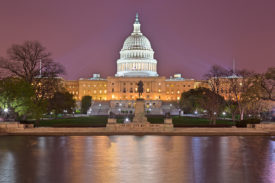 When I consider the hurdles to reforming state or federal constitutions, I’m reminded of the tale about the lost traveler who called out for directions to a farmer in a field. “If I were going there,” the farmer eventually hollered back, “I wouldn’t start from here.”
When I consider the hurdles to reforming state or federal constitutions, I’m reminded of the tale about the lost traveler who called out for directions to a farmer in a field. “If I were going there,” the farmer eventually hollered back, “I wouldn’t start from here.”
Richard Rosenfeld, in Harper’s writes of how deeply embedded in the Constitution is the power of the Senate. For example, it says, “No State, without its Consent, shall be deprived of its equal suffrage in the Senate.” Even in a constitutional convention, votes are taken by state, not per capita, so there’s no reason to believe small states would bargain away their absurdly exaggerated influence in the Senate.
What can we do to revise small-state rule in the Senate?
Rosenfeld himself gamely suggests taking steps to gradually make the Senate less powerful, until it has faded away to an advisory role like the House of Lords. That’s a many-decade prospect, and Rosenfeld does not say what steps he has in mind, nor does he offer any compelling reason why small states would go along.
This blogger suggests a faster and more clever strategy, though far-fetched: it might be within the Senate’s rule-making powers to put weights on each Senator’s vote to reflect the relative size of his or her constituency, just as the Constitution originally weighted each slave as 3/5ths of a person for the purposes of apportioning Representatives. The Constitution doesn’t explicitly forbid such a practice, although the whole intent of the Senate was to give each state “equal suffrage.” Still, under this proposal, Wyoming would have two senators, and those senators would each get to vote. But their votes would count one-sixty-eighth as much as would the votes of California’s senators. It’s hard to imagine this passing the straight-face test, much less actually winning approval (and I haven’t even talked yet about how hard it is to change Senate rules), but it would sure fix the Senate.
An equally creative—and far-fetched strategy—is the brainchild of Michael Lind, now at the New America Foundation in Washington, DC. He sketched a course in 1998 by which the populous states could perform cellular mitosis, splitting themselves up until there were about 75 states and the imbalances in Senate representation were markedly diminished. (His “75 Stars” article remains the best thing I’ve read about the Senate and its reform. I recommend it! UPDATE, 4/4/2010: A newer and equally insightful piece is by Ezra Klein in Newsweek.) The trouble is, can you imagine a scenario in which California’s governor and legislature would approve of splitting the Golden State in eight? If you can get past that, why would the small-state-ruled Senate approve admission of the new states? And what would stop Wyoming from subdividing too?
I haven’t given up on fixing the Senate undemocratic composition, but I sure haven’t heard a strategy that seems likely to succeed. A revolution? It’s almost enough to bring despair to a believer in the principle of one person, one vote.
For myself, while I await a viable strategy for making the Senate democratic, I console myself with a fantasy: organized migration from big states to small ones. The margins of political victory in the 2004 and 2008 US Senate races in Alaska were 3,953 and 9,349 respectively. A detachment of 10,000 voting transplants from southern Cascadia—say, Mendocino County, California—to stunning Sitka, Alaska (pictured atop this post), might be enough to rewrite the course of US politics substantially. Lawyer friend Rod Brown of Seattle tells me that 30-days residency and the intent to remain are all it takes to register and vote in Alaska, according to state law.
 A larger migration would be needed to Wyoming, where in 2008, a US Senate landslide in Wyoming was won by 129,000 votes. In 2006, the margin was 77,500. Still, Jackson Hole (pictured!) is beautiful and a lot of Californians own homes there anyway: why don’t they just stay a little longer and change their voter registration? Rod Brown adds that the state of Wyoming’s residency requirements for voters are minimal: you just have to move there with the intent to make it your principal residence. No duration is specified. Perhaps northwesterners from heavily populated states could serve volunteer terms in Jackson Hole? (For a small stipend from my fellow Washingtonians, I hereby volunteer to lead the advance party, to scout the Jackson area. I’m willing to go in either climbing or skiing season. Anyone care to join me?)
A larger migration would be needed to Wyoming, where in 2008, a US Senate landslide in Wyoming was won by 129,000 votes. In 2006, the margin was 77,500. Still, Jackson Hole (pictured!) is beautiful and a lot of Californians own homes there anyway: why don’t they just stay a little longer and change their voter registration? Rod Brown adds that the state of Wyoming’s residency requirements for voters are minimal: you just have to move there with the intent to make it your principal residence. No duration is specified. Perhaps northwesterners from heavily populated states could serve volunteer terms in Jackson Hole? (For a small stipend from my fellow Washingtonians, I hereby volunteer to lead the advance party, to scout the Jackson area. I’m willing to go in either climbing or skiing season. Anyone care to join me?)
OK, I’ll be serious: I’m still looking and hoping. Perhaps you’ve got an idea? A plan? A better understanding of the US Constitution?
Meanwhile, I note that changing the composition of the Senate is much harder than changing the Senate’s filibuster rule. And the filibuster is half the problem with the US Senate. It’s the subject of my next post.
Photos of Sitka, Alaska and Jackson Hole, Wyoming courtesy of Flickr photographers muirtrail68 and wvdave.geo under Creative Commons Licensing.









Matt the Engineer
I think you found your solution in a previous post. Instead of splitting off states, let’s merge a few. Perhaps the big states could propose marriage to the little states, creating fewer small-state senate seats. The reasons a small state might be interested in this is the same reason parts of unincorporated counties are happy to become part of a city: with size comes money and power unavailable to smaller entities. Plus we all know Washington <3's Alaska.
Alan Durning
The Wall Street Journal of April 17 has a feature on the long history of efforts by parts of states to break off into new states. It’s based on Michael Trinklein’s book “Lost States: True Stories of Texlahoma, Transylvania, and Other States That Never Made It.” There’s also an interactive map , which draws attention to two past Northwest states-in-waiting: “Shasta” and “Lincoln.”Interesting things I learned:- If Puerto Rico and Washington, DC, were to win statehood, it would have interesting impacts on US politics.- Long Island, New York, has a nontrivial independence movement, seeking statehood.- Texas was admitted to the union with an understanding that it could divide itself into several separate states.- Southern California long ago attempted to separate itself from northern California.